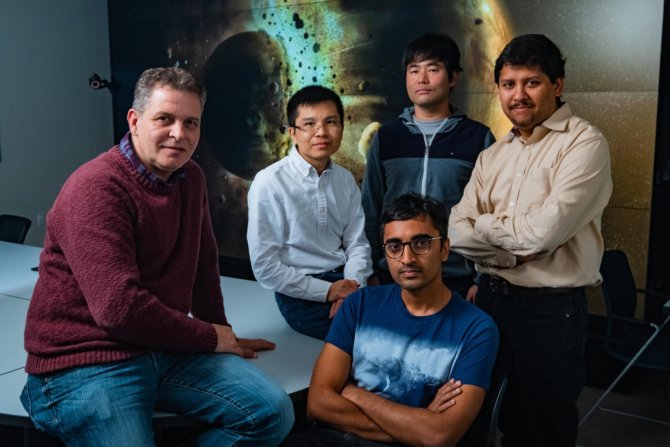
Jan. 28, 2019
Feature Story
The Moon-Forming Impact And Its Gifts

A study by Rice University scientists (from left) Gelu Costin, Chenguang Sun, Damanveer Grewal (sitting), Kyusei Tsuno, and Rajdeep Dasgupta found Earth most likely received the bulk of its carbon, nitrogen, and other life-essential elements from the planetary collision that created the moon more than 4.4 billion years ago. The findings appear in the journal Science Advances.Image credit: Jeff Fitlow/Rice University.
The question of how life-essential elements such as carbon, nitrogen and sulfur came to our planet has been long debated and is a clearly important and slippery scientific subject.
Did these volatile elements accrete onto the proto-Earth from the sun’s planetary disk as the planet was being formed? Did they arrive substantially later via meteorite or comet? Or was it the cataclysmic moon-forming impact of the proto-Earth and another Mars-sized planet that brought in those essential elements?
Piecing this story together is definitely challenging, but now there is vigorous support for one hypothesis — that the giant impact brought us the elements would later be used to enable life.
Based on high pressure-temperature experiments, modeling and simulations, a team at Rice University’s Department of Earth, Environmental and Planetary Sciences makes that case in Science Advances for the central role of the proto-planet called Theia.
“From the study of primitive meteorites, scientists have long known that Earth and other rocky planets in the inner solar system are volatile-depleted,” said study co-author Rajdeep Dasgupta. “But the timing and mechanism of volatile delivery has been hotly debated. Ours is the first scenario that can explain the timing and delivery in a way that is consistent with all of the geochemical evidence.”
“What we are saying is that the impactor definitely brought the majority supply of life-essential elements that we see at the mantle and surface today,” Dasgupta wrote in an email.
Read the full article from Many Worlds.
The study, “Delivery of carbon, nitrogen, and sulfur to the silicate Earth by a giant impact,” was published in the journal Science Advances. The work was supported by a NASA-funded effort called CLEVER Planets, an interdisciplinary, multi-institutional group, led by PI Rajdeep Dasgupta of Rice University, Houston, TX. CLEVER Planets is one of teams in the Nexus of Exoplanetary Systems Science (NExSS).